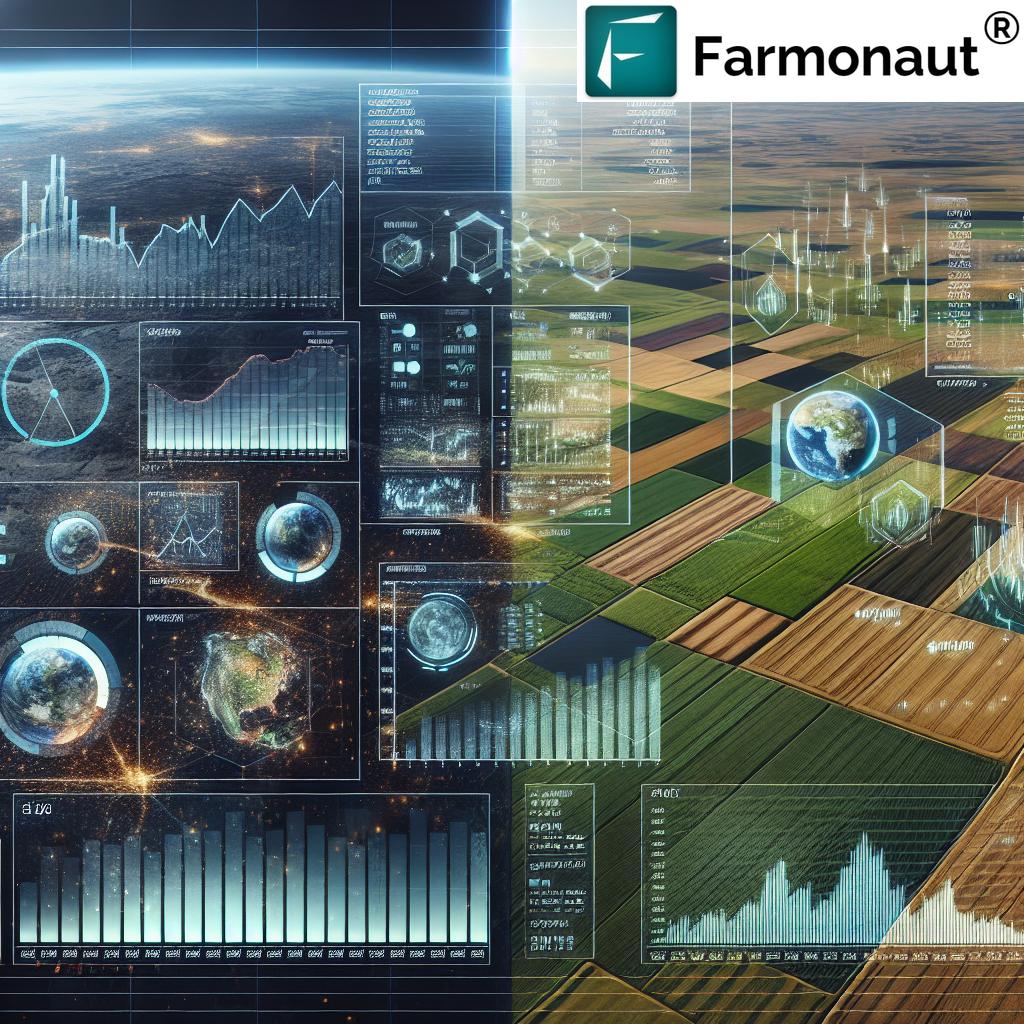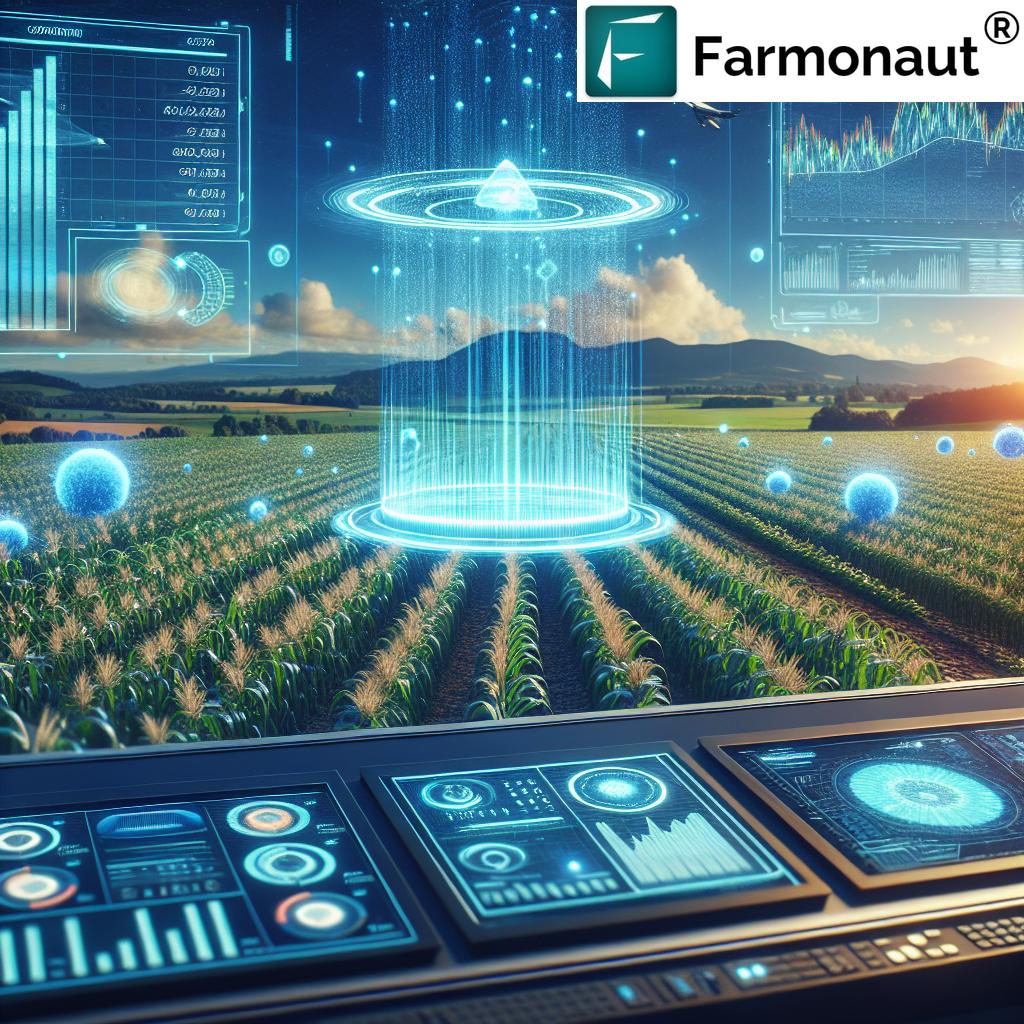Revolutionizing Agricultural Futures: Farmonaut’s Precision Analytics for Smart Farm Risk Management

“Clearing members in agricultural futures trading must meet strict capital requirements, often exceeding $5 million in net capital.”
In the ever-evolving landscape of agriculture, the fusion of traditional farming practices with cutting-edge technology is revolutionizing the way we approach agricultural futures trading and farm risk management. At the forefront of this transformation is Farmonaut, a pioneering agritech company that’s reshaping the industry with its innovative precision analytics and smart farming solutions. In this comprehensive blog post, we’ll delve into the intricate world of agricultural futures trading, exploring how Farmonaut’s advanced technologies are empowering farmers, traders, and agribusinesses to navigate the complexities of the market with unprecedented accuracy and insight.
Understanding Agricultural Futures Trading and Farm Commodity Options
Agricultural futures trading and farm commodity options are sophisticated financial instruments that play a crucial role in managing risk and price volatility in the agricultural sector. These products allow farmers, traders, and agribusinesses to hedge against potential losses and capitalize on market opportunities.
- Agricultural Futures: Contracts that obligate the buyer to purchase a specific quantity of an agricultural commodity at a predetermined price on a future date.
- Farm Commodity Options: Financial derivatives that give the holder the right, but not the obligation, to buy or sell a specific agricultural commodity at a set price within a certain timeframe.
The importance of these financial products in modern agriculture cannot be overstated. They provide:
- Price stability for farmers
- Risk management tools for agribusinesses
- Investment opportunities for traders
- Market liquidity and price discovery mechanisms
The Role of Clearing Members in Agricultural Futures Trading
Clearing members are the backbone of the agricultural futures trading ecosystem. These financial institutions play a pivotal role in facilitating transactions and managing risk within the market. Let’s explore their critical responsibilities:
- Transaction Facilitation: Clearing members act as intermediaries between buyers and sellers, ensuring smooth execution of trades.
- Risk Management: They assess and manage the financial risk associated with each transaction.
- Margin Collection: Clearing members collect and manage margin requirements from traders to cover potential losses.
- Settlement: They handle the financial settlement of trades, ensuring that funds are transferred correctly between parties.
- Regulatory Compliance: Clearing members must adhere to strict regulatory guidelines and reporting requirements.
The process of becoming a clearing member is rigorous and demands substantial financial resources and expertise. Key requirements include:
- Capital Requirements: Substantial net capital, often exceeding $5 million, to ensure financial stability.
- Financial Reporting: Regular submission of detailed financial statements and reports.
- Operational Infrastructure: Robust systems and processes to handle large volumes of trades and risk management tasks.
- Regulatory Approval: Clearance from relevant regulatory bodies and exchanges.
- Expertise: Demonstrated knowledge and experience in futures trading and risk management.
Farmonaut’s Innovative Approach to Agricultural Market Insights
In this dynamic landscape of agricultural futures trading, Farmonaut emerges as a game-changer. By leveraging advanced technologies such as satellite imagery, artificial intelligence, and machine learning, Farmonaut provides unparalleled insights into crop health, yield predictions, and market trends.
Key features of Farmonaut’s precision agriculture analytics include:
- Satellite Crop Monitoring: Real-time analysis of crop health and growth patterns across vast areas.
- AI-Driven Yield Predictions: Accurate forecasting of crop yields based on historical data and current conditions.
- Weather Integration: Incorporation of weather data to assess potential impacts on crop production and market prices.
- Market Trend Analysis: Advanced algorithms that identify emerging patterns in agricultural markets.
These tools provide traders, clearing members, and agribusinesses with a significant edge in understanding market dynamics and making informed decisions.
The Impact of Precision Agriculture Analytics on Risk Management
Farmonaut’s precision agriculture analytics are revolutionizing risk management in agricultural futures trading. By providing accurate, timely data on crop conditions and market trends, these tools enable:
- Enhanced Decision-Making: Traders and clearing members can make more informed choices based on real-time data.
- Improved Risk Assessment: Better understanding of potential crop yields and market conditions leads to more accurate risk evaluations.
- Proactive Risk Mitigation: Early identification of potential issues allows for timely interventions and hedging strategies.
- Optimized Portfolio Management: Clearing members can better balance their portfolios based on comprehensive market insights.
“Satellite crop monitoring can analyze over 10,000 acres of farmland in a single day, providing crucial data for precision agriculture.”
Exploring Fee Structures and Incentives in Agricultural Futures Trading
Understanding the fee structures and incentives associated with agricultural futures trading is crucial for both clearing members and traders. These financial aspects can significantly impact trading strategies and profitability.
- Exchange Fees: Charges levied by the exchange for each transaction.
- Clearing Fees: Costs associated with the clearing and settlement of trades.
- Regulatory Fees: Charges imposed by regulatory bodies to oversee market activities.
- Incentive Programs: Rebates or reduced fees for high-volume traders or market makers.
- Membership Tiers: Different levels of exchange membership with varying fee structures and benefits.
Farmonaut’s analytics can help traders and clearing members optimize their strategies to take full advantage of these fee structures and incentives, potentially increasing profitability.
The Role of Smart Farming Technologies in Agricultural Risk Management
Smart farming technologies are transforming agricultural risk management, and Farmonaut is at the forefront of this revolution. These technologies provide unprecedented insights into farm operations, enabling more effective risk mitigation strategies.
Key smart farming technologies offered by Farmonaut include:
- IoT Sensors: Real-time monitoring of soil conditions, moisture levels, and crop health.
- Drone Imagery: High-resolution aerial imagery for detailed crop analysis.
- AI-Powered Analytics: Advanced algorithms that process vast amounts of data to provide actionable insights.
- Blockchain Integration: Ensuring data integrity and traceability in the agricultural supply chain.
These technologies enable farmers and agribusinesses to:
- Optimize resource usage
- Predict and mitigate potential crop failures
- Improve overall farm productivity
- Enhance decision-making in futures trading
Explore Farmonaut’s API for advanced data integration
Comparison of Clearing Membership Types
| Membership Type | Capital Requirements | Financial Reporting Frequency | Regulatory Compliance Level | Fee Structure | Product Access | Risk Management Responsibilities |
|---|---|---|---|---|---|---|
| Individual Clearing Member | $500,000 – $1,000,000 | Monthly | 3/5 | Standard | Limited | Moderate |
| Corporate Clearing Member | $2,000,000 – $5,000,000 | Bi-weekly | 4/5 | Tiered | Extensive | High |
| General Clearing Member | $5,000,000+ | Weekly | 5/5 | Premium | Full | Comprehensive |
Navigating Regulatory Challenges in Agricultural Futures Trading
The regulatory landscape of agricultural futures trading is complex and ever-changing. Clearing members and traders must navigate a myriad of rules and regulations to ensure compliance and maintain market integrity.
- Reporting Requirements: Regular submission of financial statements and trading activity reports.
- Capital Adequacy: Maintaining sufficient capital to cover potential losses and meet regulatory standards.
- Risk Management Protocols: Implementing robust systems to monitor and manage market and credit risks.
- Anti-Money Laundering (AML) Compliance: Adhering to strict AML regulations to prevent financial crimes.
- Market Surveillance: Participating in efforts to detect and prevent market manipulation and fraud.
Farmonaut’s data-driven insights can assist clearing members and traders in maintaining regulatory compliance by providing accurate, timely information on market conditions and trading activities.
Leveraging Farm Financial Products for Risk Mitigation
Farm financial products play a crucial role in risk mitigation for agricultural businesses. These products, when combined with Farmonaut’s precision analytics, can provide powerful tools for managing financial risks in farming operations.
- Crop Insurance: Protects against yield losses due to natural disasters or price declines.
- Revenue Protection: Guarantees a certain level of revenue regardless of yield or price fluctuations.
- Weather Derivatives: Financial instruments that hedge against adverse weather conditions.
- Forward Contracts: Agreements to sell crops at a predetermined price before harvest.
Farmonaut’s satellite crop monitoring and yield prediction tools can enhance the effectiveness of these financial products by providing accurate data for risk assessment and pricing.
The Future of Agricultural Risk Management with Farmonaut
As we look to the future, Farmonaut’s innovative technologies are poised to play an increasingly crucial role in agricultural risk management. The integration of advanced analytics, satellite monitoring, and AI-driven insights will continue to transform how we approach agricultural futures trading and farm risk management.
Key trends to watch:
- Predictive Analytics: More accurate forecasting of crop yields and market trends.
- Real-Time Data Integration: Seamless incorporation of live data into trading and risk management systems.
- Automated Risk Assessment: AI-powered systems that continuously evaluate and adjust risk profiles.
- Blockchain for Transparency: Enhanced traceability and security in agricultural supply chains.
- Personalized Risk Management Strategies: Tailored approaches based on individual farm characteristics and market conditions.
Explore Farmonaut’s API Developer Docs for advanced integration
Conclusion: Embracing the Agricultural Technology Revolution
The agricultural futures trading landscape is undergoing a profound transformation, driven by innovative technologies and data-driven insights. Farmonaut’s precision analytics and smart farming solutions are at the forefront of this revolution, providing clearing members, traders, and agribusinesses with the tools they need to navigate complex markets and manage risks effectively.
By embracing these advanced technologies and leveraging the power of data, stakeholders in the agricultural sector can:
- Make more informed trading decisions
- Implement more effective risk management strategies
- Enhance regulatory compliance
- Improve overall farm productivity and profitability
As we move forward, the integration of Farmonaut’s cutting-edge solutions with traditional agricultural practices will continue to drive innovation and efficiency in the industry. The future of agricultural risk management is here, and it’s powered by precision, data, and technology.
FAQ Section
Q: What is agricultural futures trading?
A: Agricultural futures trading involves contracts to buy or sell specific quantities of agricultural commodities at predetermined prices on future dates. It’s a way for farmers, traders, and agribusinesses to manage price risks and secure future prices for their products.
Q: How does Farmonaut’s technology contribute to agricultural risk management?
A: Farmonaut’s technology uses satellite imagery, AI, and machine learning to provide real-time crop health monitoring, yield predictions, and market trend analysis. This data helps farmers and traders make informed decisions, assess risks more accurately, and implement effective risk management strategies.
Q: What are the capital requirements for becoming a clearing member in agricultural futures trading?
A: Capital requirements vary depending on the type of clearing membership but typically range from $500,000 for individual clearing members to over $5 million for general clearing members. These requirements ensure financial stability and risk management capability.
Q: How can smart farming technologies improve agricultural productivity?
A: Smart farming technologies, such as those offered by Farmonaut, improve productivity by providing real-time data on crop health, soil conditions, and weather patterns. This enables farmers to optimize resource usage, predict potential issues, and make data-driven decisions to maximize yields and efficiency.
Q: What role does blockchain play in agricultural risk management?
A: Blockchain technology enhances transparency and traceability in agricultural supply chains. It can help verify the origin and journey of agricultural products, reduce fraud, and improve trust between buyers and sellers. This technology also supports more efficient and secure transactions in agricultural futures trading.







